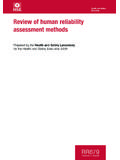Transcription of The Causes of Major Hazard Incidents and How to Improve ...
1 Harpur Hill, Buxton derbyshire , sk17 9JN T: +44 (0)1298 218000 F: +44 (0)1298 218590 W: The Causes of Major Hazard Incidents and How to Improve Risk Control and Health and Safety Management: A Review of the Existing Literature HSL/2006/117 Project Leader:Julie Bell Author(s):Julie Bell & Nicola Healey Science Group:Human Factors Crown copyright (2006) ii CONTENTS 1 1 Background.
2 1 1 2 3 3 FINDINGS FROM THE LITERATURE 4 The Causes attribued to Major Hazard Incidents .. 4 Control measures and behaviours to prevent Major Hazard Incidents .. 9 Safety related behaviours that need to be changed to prevent Major Hazard Incidents .. 18 The most effective ways of changing 21 Impact of organisational change factors on effective risk control and safety 25 Additional requirements for preventing Major Hazard Incidents .. 28 Utility of current reporting systems to identify probable Causes of Major Hazard indcidents.
3 29 Where HSE should target its 30 4 33 The existing evidence base .. 33 Possible gaps in the evidence base and suggestions for how they could be 34 Recommendations for HSE 36 5 37 6 APPENDIX A: Major ACCIDENT CASE STUDIES .. 41 41 Nuclear .. 44 48 Rail .. 50 Air .. 52 Coal 55 7 APPENDIX B: SUMMARY OF REVIEW PAPERS .. 57 iii EXECUTIVE SUMMARY Introduction The Health and Safety Executive (HSE) commissioned the Health and Safety Laboratory (HSL) to carry out a review of the existing literature on the Causes of Major Hazard Incidents and the relevant control measures and behaviours that can prevent Incidents occurring.
4 This research is an important first step in taking forward Social Science support for the Major Hazards Strategic Programme. The research is needed to take stock of the existing evidence base, identify gaps and suggest how these gaps might be addressed by further research. The objectives of the review were to: 1. Scope what existing research literature is available to address specific questions relating to the understanding and control of Major Hazard accidents; 2. Review and report on how far the existing evidence can provide answers to the research questions; 3.
5 Assess the quality of existing research evidence and provide comments on the overall quality of the evidence base and the robustness of individual studies; 4. Identify gaps in the existing evidence base and suggest how these gaps might be addressed; 5. Make recommendations on what style of interventions HSE should be pursuing in light of the research evidence. Main Findings 1. The existing evidence base Underlying Causes of Major accidents and associated control measures There is significant and robust information about, and common agreement on, the probable and underlying Causes of Major accidents and Incidents in the Major Hazard industry.
6 There is an extensive, good quality evidence base for the control measures needed to prevent Major Hazard Incidents . Establishing and maintaining a positive safety culture is the focus of this work and is based on findings detailed accident investigations and analytical studies from across industry. While the theory of what is required is comprehensive the translation of this knowledge into practical solutions and interventions, to prevent Major accidents, is limited.
7 Therefore, the evidence base cannot be considered robust. Behaviours associated with Major accidents and how to change them There are behaviours that need to be changed in all the Major Hazard industries, but there is insufficient evidence to draw any conclusions about what those specific behaviours are, or how this is different (if at all) between hazardous industries. Management commitment to safety and the perceived pressure for productivity is highlighted in a thorough, qualitative investigation of the rail industry.
8 This experience also may be relevant to Major Hazard industries but, notwithstanding findings from the offshore industry, this has not been investigated sufficiently to be certain. iv There is research on how to change behaviour but this is limited, based on small-scale studies and focused on individual behaviour and leadership styles.
9 Training is not generally an effective way of changing behaviour but can be of use in specific circumstances simulation of emergency responses. The means for changing behaviour has been researched but the evidence base is not robust and does not provided a conclusive view on the most effective ways to change safety behaviour. A better understanding of the specific behaviours to be changed is essential before the research on how to change behaviour can be sufficiently developed.
10 Organisational change and Major accidents There is circumstantial evidence, from case study examples, to indicate a link between organisational change and accidents. It is, therefore, an issue for the management of health and safety by Major Hazard industry and should be part of the safety management system. An example from the chemical processes industry shows that change can be effectively managed through the development of management change guidelines for changing key safety tasks.










